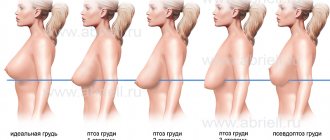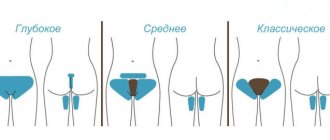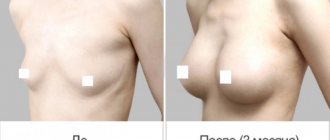What should a woman's breasts look like ideally? If you don’t concentrate on a specific size and shape, it will probably be enough to say that the bust is supposed to be elastic and proportional and be located strictly “at the place of registration.”
Unfortunately, due to various reasons, such as heredity, gravity, feeding a child, hormonal disorders, weight loss and age-related changes, a woman’s breasts can prematurely lose their shape and droop, becoming a source of constant dissatisfaction and complexes for their owner.
Plastic breast lift surgery – mastopexy – can give such patients self-confidence.
1
Breast correction surgery
2 Breast correction surgery
3 Breast correction surgery
Main objectives of the operation
The global goal of the operation is to restore the breasts to their former attractiveness.
For a surgeon, the global goal is divided into many smaller goals:
- return the nipple to the level of the skin fold under the mammary gland;
- eliminate excess skin;
- give your breasts a natural shape;
- eliminate asymmetry;
- if necessary, reduce the diameter of the nipple areola.
In most cases, the surgeon applies special markings to the patient’s body before the operation. The incision sites are marked with ink while the patient is sitting or standing with her arms hanging loosely at her sides.
To determine the future shape of the breast, the doctor uses a measuring tape and sometimes special templates. To determine the correct position of the nipple, the surgeon first feels the fold of skin under the mammary gland with his finger. Normal nipples are usually located at its level. Then the doctor positions the nipples symmetrically horizontally and vertically.
Preliminary marking allows you to reduce the time the patient is in a state of anesthesia or drug sedation, since the surgeon does not need to waste time choosing the correct and symmetrical incision lines during the operation. Also, the surgeon does not have to visually calculate the displacement of tissues when the patient is lying down compared to standing or sitting, which improves the result of the operation.
Indications for circular mastoplexy
This method of lifting is good for women with elongated breasts. As a result of the operation, the breasts become flatter because the skin in this area is removed and tightened. This type of plastic surgery is indicated for women and girls with minimal mastoptosis (breast drooping) after:
- feeding and childbirth;
- serious weight loss and active loss of fatty tissue in the chest area with a small gland size;
- for middle-aged patients who want to regain their girlish forms.
This type of operation is possible when:
- maintaining the elasticity of breast tissue and a slight decrease in volume;
- decrease in tissue elasticity and slight decrease in volume.
In case of severe ptosis, periareolar technology is not recommended, because serious tissue tension is created at the suture site. This may cause postoperative complications.
Indications
- For women after the end of lactation, when the glandular component of the mammary glands decreases, and the excess skin volume remains.
- For women after losing weight in cases where special creams to restore skin elasticity are not effective enough, and placement of implants is unacceptable for any reason.
- Women at an age when the skin loses its elasticity and the force of gravity begins to exert its influence on the breasts.
- Women who have decided to refuse implants, but want to maintain a beautiful breast shape.
Video: Breast anatomy
Breast lift, where will the incisions and stitches be?
Mastopexy is a more complex operation than regular breast augmentation. Depending on the initial condition and goals of correction, it can be performed in several ways. Dr. Bakov always selects the one that will allow you to achieve the most natural and beautiful breast shape and will not leave too noticeable traces of the operation.
Before and After Photos
Periareolar breast lift
Mastopexy is a more complex operation than regular breast augmentation. Depending on the initial condition and goals of correction, it can be performed in several ways. Dr. Bakov always selects the one that will allow you to achieve the most natural and beautiful breast shape and will not leave too noticeable traces of the operation. Increasing breast volume with implants will additionally lift the breasts and enhance the lifting effect so that the overall result will be very natural and beautiful.
Breast lift with vertical incision
For more noticeable breast ptosis, quite a lot of excess skin will need to be removed. In this case, to achieve a beautiful result, you will need to use an additional vertical cut. Many patients are worried about the postoperative stitches that it will leave. To evaluate whether this is so noticeable, watch our video “Stitches after a breast lift”:
Anchor breast lift
This method of mastopexy helps improve the shape of the breast even in the most severe cases. The incisions in this case are shaped like an anchor (around the areola, vertical and in the inframammary fold). Postoperative sutures in this case are no more noticeable than traces of a vertical breast lift.
Contraindications
- Lactation. Less than a year has passed since the end of lactation. Or a woman plans to become pregnant and breastfeed soon.
- Blood diseases, blood clotting disorders.
- Diseases of the cardiovascular and respiratory system are acute, exacerbation of chronic ones or in a state of decompensation.
- Severe diabetes mellitus.
- Infectious diseases.
- Active tuberculosis of any localization.
- Oncology of any localization.
- The presence of a large number of cysts or lumps in the mammary glands, or the presence of large cysts and lumps that require treatment.
Disadvantages of breast augmentation through the areola
- With a small diameter of the areolas, the patient is limited in choosing the size of implants.
- There is an increased risk of damage to nerve endings and milk ducts, which can negatively affect a woman's ability to lactate. This does not mean that after breast augmentation through the areola, the patient will lose the ability to breastfeed. According to statistics, 7% of women experience difficulties with milk production during pregnancy, which is only in isolated cases associated with mammoplasty. Doctors at the Pirogov Clinic have successfully performed more than 10,000 thousand plastic surgeries since 1999. By contacting us, you can be sure that at all stages of the operation, from examination to completion of rehabilitation, you will receive medical care based on high professionalism and sensitive attention to your health.
Medical examination
- Tests: general blood and urine tests, blood from a vein for biochemistry, syphilis, hepatitis B and C, AIDS, blood group and Rh factor.
- Instrumental examination: mammography or ultrasound of the mammary glands, ECG, fluorography.
- Consultations: surgeon (to determine indications for surgery and select the type of operation), therapist (to identify contraindications to surgery), mammologist (if there are changes on the mammogram or ultrasound).
The list of examinations may be expanded in the presence of chronic diseases of internal organs, arteries or veins, or other diseases. For example, if a patient has varicose veins in the legs, it will be necessary to perform an ultrasound examination of the leg veins and consult a vascular surgeon.
All examination results are valid for only 2 weeks before surgery, so it is advisable to allocate time in your busy schedule to take tests and consult with specialists.
Follow this link to learn more about all types of breast lifts after breastfeeding.
Want to know what happens to your breasts during and after feeding? That way.
Scars after breast lift
The possibility of scarring does not stop our patients from undergoing surgery. Firstly, the surgeon will do everything to ensure that the scar is neat and inconspicuous. If the scar still causes discomfort, at LINLINE you can undergo laser scar removal using the RecoSMA method. This is a safe and painless procedure that replaces scar tissue with healthy tissue. Read more about the procedure. We give the first procedure to plastic surgery patients absolutely free.
| Consultation with a plastic surgeon | 0 ₽ | Call |
| Traditional mastopexy without reduction | from 150000 ₽ | Call |
| Traditional mastopexy with breast volume reduction | from 250000 ₽ | Call |
| Circular mastopexy | from 120000 ₽ | Call |
Call us!
Restrictions to be observed
- Smoking.
Typically, surgeons recommend stopping smoking 2 weeks before surgery and abstaining from smoking for another 3 weeks after it, as this affects the rate of tissue healing and scar formation at the postoperative suture site.
- Medicines.
For two weeks you should not take any drugs that affect blood viscosity and blood clotting rate. Usually, a general practitioner or surgeon introduces the list of such drugs to the patient during a consultation. On your doctor's recommendation, you may need to take certain medications to prevent complications.
- Alcohol.
A week before surgery, you should stop drinking alcohol, regardless of whether it is part of alcoholic beverages or medications.
Alcohol impairs the functioning of the liver and kidneys, which experience a heavy load during and after surgery: they neutralize and eliminate drugs for anesthesia, painkillers and antibiotics, as well as toxic products that are formed as a result of massive tissue damage.
- Food and drink.
The day before surgery you should not eat a large breakfast. It is advisable to drink water instead of lunch and dinner. Drinking and eating are prohibited on the day of surgery.
Why should mammoplasty be done in our clinic?
Behind the plastic surgeons of the clinic named after. N.I. Pirogov has vast experience in aesthetic and reconstructive operations on the mammary gland. The work of our doctors is marked by hundreds of grateful reviews and the annual rating of independent experts published in the publication “City 812”. According to the voting results, our plastic surgeons are recognized as the best in St. Petersburg. On this website and on social networks you can view the portfolio of each doctor.
Our clinic offers patients:
- Good material and technical equipment of medical offices and wards. We use new generation equipment from leading manufacturers. Comfortable 1- and 2-bed hospital rooms are equipped according to the model of European private clinics.
- Nursing care and round-the-clock supervision by a doctor on duty.
- Availability of own laboratory and intensive care unit. You can complete the entire preoperative examination in 1 day, and get accurate results within 2 days: by email or by directly contacting the clinic.
- A wide range of specialists and doctors of various profiles whose help may be required.
- Regular discounts on mammoplasty and all inclusive promotional offers at competitive prices.
- For patients from other cities - organizational assistance from a curator at all stages: from consultation to discharge.
- Possibility of gradual repayment of the transaction amount (interest-free installments, loan).
Call us at this number and we will answer your questions and help you make an appointment with a plastic surgeon.
How is the operation performed?
In most cases, general anesthesia is used for the operation, since the operation can take from 1.5 to 3 hours. Two incisions are made on the skin of the chest. One circular incision goes around the nipple in a circumference.
The second one goes through a circular cut and goes around the first one at some distance. The ring of skin between the incisions is then removed, and the skin located behind the second incision is sutured to the nipple.
In most cases, absorbable sutures are applied to the tissue deep in the wound, and the skin is sutured with thin nylon thread.
Sometimes a drainage tube may be left in the wound to drain blood and tissue fluid, which seeps into the wound and can cause inflammation.
Since after the operation the tissues at the site of the postoperative incision are under tension due to the tension of the skin on different sides of the nipple, the sutures must be additionally secured with a surgical plaster.
Postoperative period
The patient spends the first day after surgery in the recovery room under the supervision of medical staff. In the first hours after surgery, there may be nausea and vomiting, so you should not drink or eat during this time. In case of intense thirst, you can only wet your lips and tongue with clean water.
After the effect of the anesthetic drug has stopped, there may be pain of varying degrees of intensity in the area of the operated breast. The pain is caused by both tissue trauma during surgery and the increase in swelling.
In order not to provoke pain and not increase swelling, it is recommended:
- immediately after the operation, put on compression garments;
- do not raise your arms above your shoulders, do not make sudden movements with your arms;
- do not take positions in which increased tension is felt in the area of postoperative sutures.
On the second day, if the first days went well, the patient is discharged home.
Photo: compression garments
At home, you will need to wear compression garments around the clock for at least three more weeks. Then you can only walk in it during the day and play sports in it. In the first two to three days at home, you may experience pain in the chest area, which normally gradually subsides. During these days, you can take painkillers prescribed by your doctor.
The area of the surgical wound should not be wet for a week after surgery. You can shower after the surgeon has assessed the condition of the stitches. This usually happens on days 7-10. Taking a bath is not recommended as this may increase swelling.
Sutures are removed 10-14 days after surgery. While the stitches are not removed, they must be treated with an antiseptic solution at least once a day. Light manual manipulations (working in the kitchen, driving a car, etc.) can be started from the second week after surgery.
After a month, you can resume playing sports, but you need to take the choice of exercises seriously, since any loads that stretch the postoperative scars will make the scars wider and rougher. Scars mature completely by the fourth month after surgery.
During the first four weeks, baths, saunas, solariums and any other procedures that may have a thermal effect on the chest are prohibited. Heat increases swelling, which puts additional stress on the scars and stretches them.
The swelling may go away within 3-4 months. Only after the swelling has completely disappeared will it be possible to evaluate the results of the operation.
For a whole year, you should not expose your scars to direct sunlight (sunbathing topless), so as not to cause pigmentation of the scars.
Operation technology
During the procedure, the nipple is not separated from the skin; it is moved to a higher position, like a lifted breast. Excess sagging breast skin is also removed. There are several ways to perform a mastopexy. The choice of a specific technique depends on the degree of ptosis (drooping) of the mammary glands:
- Half-moon cut.
- Circular mastopexy.
- T-shaped cut.
- Vertical short seam technique.
Another important point is that mastopexy does not restore the structure of the glands, but lifts them and corrects their shape. One of the consequences of the procedure may be a reduction in bust size. Therefore, the operation is often combined with the installation of silicone implants to increase the size of the glands.
Preparation and collection of analyzes
To get good results with minimal risk to health, you need to take preparation seriously. The first stage is consultation with specialists. Before the procedure, a woman will need to consult the following doctors:
| Specialist | Medical actions |
| Mammologist | Conducts examination, palpation and hardware examination of the breast for the presence of neoplasms, cysts, inflammatory processes in the mammary glands, which is an absolute contraindication to a breast lift. If the patient’s breasts are healthy, the doctor gives permission to perform a lift. |
| Therapist | Before the procedure, it is imperative to exclude the patient from viral, infectious diseases, blood pressure problems, and the presence of diseases and conditions that may be a contraindication to mastopexy. |
| Anesthetist | Consultation with this doctor is very important, since choosing the right pain reliever will protect the patient from complications associated with an allergic and other negative reaction of the body to anesthesia. The doctor must clarify what operations the patient has undergone, whether he has chronic diseases, allergies, or whether he has a history of skull or brain injuries, or cardiovascular diseases. |
| Plastic surgeon | You will have to meet with this specialist more than once. He advises the woman about the nature of the operation, warns about all possible side effects, and does hardware modeling (that is, what results can be obtained, taking into account the initial anatomical data). |
The second stage of preparation is passing the necessary tests. These include hardware and laboratory testing. Hardware methods:
- Fluorography.
- Electrocardiogram.
- Ultrasound examination.
List of tests for laboratory examination (they are taken on an empty stomach):
- Urine.
- Biochemistry of blood.
- Blood test for prothrombin, blood group, Rh factor, HIV, syphilis, hepatitis.
In some cases, an EEG is additionally prescribed to assess the functioning of the blood vessels in the brain, and a coagulogram to clarify the ability of blood to clot.
The results of the obtained analyzes are valid for ten days.
Half the success of the operation is competent preparation and collection of all necessary tests. Before carrying out the procedure, the doctor must understand the whole picture of the patient’s current condition and correctly compare the initial data with the woman’s expectations.
Two weeks before surgery, the patient should:
- Start following a proper diet (exclude fatty, fried, smoked foods, alcohol).
- Stop smoking (nicotine doubles the risk of developing postoperative thrombosis);
- Stop using hormonal contraceptives.
A week before surgery, you should avoid using blood thinners and stop active sports and training.
The anesthesiologist must be informed of all medications taken in the week before surgery.
Ways to perform a lift
Before the operation itself, the surgeon uses a measuring tape to make markings on the patient’s chest, which allows the incisions to be made in the correct place during the procedure and prevents the development of asymmetry of the glands after the operation. Next, the skin of the chest is treated with an antiseptic solution, and anesthesia is administered.
The method of performing the operation depends on the stage of breast ptosis. There are four methods of performing mastopexy:
| Type of technique | Application cases | Method of implementation |
| Crescent cut | The initial stage of ptosis while maintaining skin tone. | The cuts begin in the upper area of the areola; during the operation, excess skin is removed, and the nipple is raised by 3-4 centimeters. |
| Circular breast lift accompanied by areola reduction | Suitable for patients with elongated mammary glands in the primary stage of ptosis. | A circular incision is made around the outer edges of the areolas. A suture is placed along the outer edges of the areola, thus tightening the skin of the bust and removing excess skin. After the procedure, folds may appear on the chest, which should disappear over time. This technology allows parallel installation of breast augmentation implants. |
| Anchor (T-shaped technique) | It is carried out during the second and third stages of breast ptosis. | It involves making vertical, horizontal incisions and cutting around the areolas. First, the incision is made along the circular area of the areola, then to the bottom in the center of the bust, where it intersects with the horizontal cut. The disadvantage of the procedure is a large number of scars. |
| Vertical short seam technique | For the category of women with beginning ptosis. | An incision is made around the nipple and vertically down the center to the fold of skin under the breast. The nipple is raised higher, and excess skin underneath is removed. The edges of the incisions are brought together and a suture is applied. This method is considered the least risky. |
| Endoscopic | Indicated for women with small breasts in the first stage of prolapse. | A puncture is made in the submammary fold and an incision is made in the axillary area. An endoscope is inserted into the gland through the incision. It is used to excise tissue. No skin incisions or stitches are made. A significant advantage is that after the operation there are few scars, which are almost invisible and heal quickly. |
The following types of mastopexy are also distinguished:
- Accompanied by reduction - breast lift and reduction due to tissue removal.
- Lifting without excision of tissue.
- Bust lifting and enlargement with implants.
- Without the use of suture accessories, when lifting is done using tissue excision.
- To tighten the bust, special tightening threads are used - they are pulled under the skin and fix the bust and adjust its shape.
Drainage is installed to drain liquids. The sutures are placed using a self-absorbing thread, which will not need to be removed later - it will dissolve on its own. After the procedure, a support bandage must be applied to the chest, and compression garments are also used.
Postoperative period
The operation lasts from one and a half to three hours. The patient is then transported to the ward. If everything went well, the woman is kept in the hospital for about three days under the supervision of a surgeon and anesthesiologist.
The procedure is performed under general anesthesia. Therefore, during the period of departure from it, the patient may feel severe pain. In this case, the doctor prescribes a pain reliever. It is usually taken for up to 7 days.
In the first couple of hours after mastopexy, it is not recommended to drink water or eat. This may lead to vomiting. If you are thirsty, you can moisten a napkin with water and apply it to your lips. It is also forbidden to raise your arms up or overload yourself physically.
If everything went well, the drainage tube, which serves to drain lymph and blood, is removed on the second day. If the outflow of fluid is strong, it is left for a couple of days.
It is also necessary to change the bandages to prevent infection. In the hospital this is done by junior medical staff. In addition, it is important to prepare comfortable post-operative underwear.
In general, discharge is carried out on the third day after surgery; in some clinics, discharge is carried out the very next day (in the absence of complications).
Possible complications
Bleeding
In case of bleeding, blood accumulates in the area of the tissue incision made during surgery. Typically, the cavity in which blood accumulates must be drained. If this is not enough, then the surgeon has to remove the sutures, look for a bleeding vessel in the wound and sew it up or apply a special clip to it, which will not allow blood to flow out of the vessel.
Inflammation
If the wound gets infected, the immune system is weakened, or antibacterial therapy is ineffective, a focus of purulent infection may develop.
The process is characterized by intense pain, increased body temperature, increased local skin temperature over the site of inflammation and redness of the skin.
Photo: complications after surgery
Loss or decreased sensitivity of the skin of the breast and nipple
This complication occurs in most cases. And in most cases it goes away on its own a few months after surgery.
Impaired healing
Photo: fat necrosis of the mammary gland
The risk of disruption of tissue healing processes is low. But in patients who are older, heavier, smokers, or have health problems, this complication nevertheless occurs.
Impaired healing manifests itself in different ways, from longer healing of the postoperative wound to the development of insufficient blood supply to the area of the postoperative wound with necrosis (death) of the skin and nipple.
Scars
A serious problem for all operations, including plastic ones. When performing a circular mastopexy, the scar runs along the edge of the pigmented skin of the areola, so it is less noticeable than, for example, with a vertical mastopexy. But nevertheless, it is still noticeable. And its location does not allow the use of laser or microdermabrasion in the nipple area.
Formation of skin clumps
If, during periareolar mastopexy, excess skin is removed and the edges of the wound are sutured inaccurately, then unsightly folds of skin may appear, which will not be easy to get rid of.
Lipomastia is associated with general obesity and is a growing problem among men. Find out everything about how to get rid of lipomastia.
Are you wondering how much it costs to get silicone breasts? Details at the link.
Is it necessary at all, or how often should breast implants be replaced? Read here.
The essence of the procedure
Periareolar lift - what is it, and how does it differ from mastoplexia, you ask? Mastoplexy is a broader concept. This is a breast lift performed using several methods:
- with the formation of a T-shaped incision;
- vertical lift;
- with the formation of a circular incision (periareolar method).
The latter option is especially attractive for patients. Because this approach involves an incision around the areolar area. And after the completion of bust correction, almost invisible scars remain on the chest. The nipple moves upward after surgery.
This method involves making two circular incisions around the areola with a small distance between them. The stretched and excess tissue is removed between the incisions and sutured along the areola line. This way a tightening effect is achieved.
The procedure can be combined with mammoplasty or performed independently. In the latter case, it takes about 60-180 minutes. The initial recovery period lasts 1-2 weeks. Compression garments will need to be worn for 1-1.5 months after surgery.
Many women confuse the described method of breast tissue lifting with the transareolar method of mammoplasty. The latter involves access through the areola with a minimal incision. This method is the most traumatic for the mammary glands, although it is attractive for patients with the minimal size of the scars.
Let us repeat that this method is used for endoprosthetics, and not for tightening the tissues of the décolleté area. Periareolar lifting is considered one of the gentle methods and has a number of advantages, although it is not indicated for all patients.










